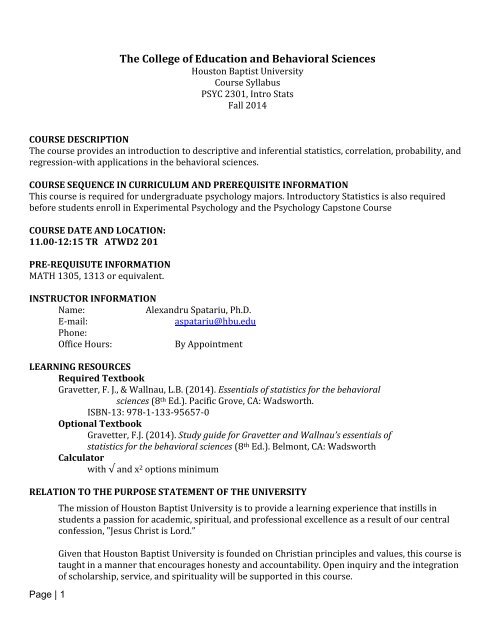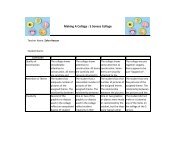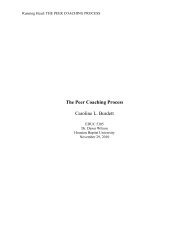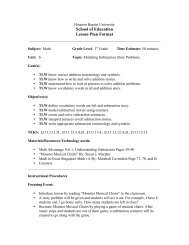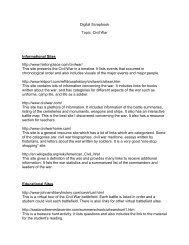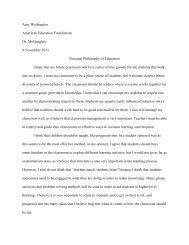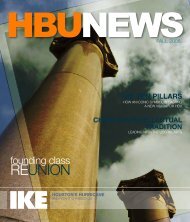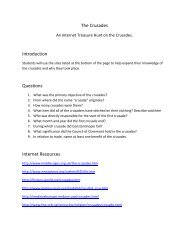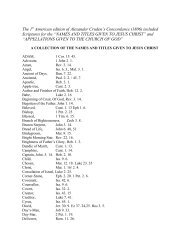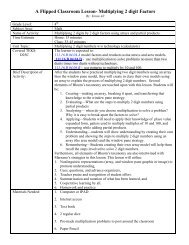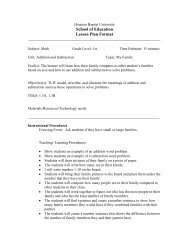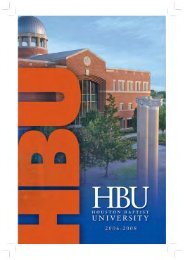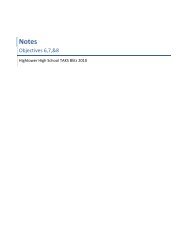Introductory Statistics (prerequisite MATH 1305 or higher)
Introductory Statistics (prerequisite MATH 1305 or higher)
Introductory Statistics (prerequisite MATH 1305 or higher)
Create successful ePaper yourself
Turn your PDF publications into a flip-book with our unique Google optimized e-Paper software.
The College of Education and Behavi<strong>or</strong>al SciencesHouston Baptist UniversityCourse SyllabusPSYC 2301, Intro StatsFall 2014COURSE DESCRIPTIONThe course provides an introduction to descriptive and inferential statistics, c<strong>or</strong>relation, probability, andregression-with applications in the behavi<strong>or</strong>al sciences.COURSE SEQUENCE IN CURRICULUM AND PREREQUISITE INFORMATIONThis course is required f<strong>or</strong> undergraduate psychology maj<strong>or</strong>s. <strong>Introduct<strong>or</strong>y</strong> <strong>Statistics</strong> is also requiredbef<strong>or</strong>e students enroll in Experimental Psychology and the Psychology Capstone CourseCOURSE DATE AND LOCATION:11.00-12:15 TR ATWD2 201PRE-REQUISUTE INFORMATION<strong>MATH</strong> <strong>1305</strong>, 1313 <strong>or</strong> equivalent.INSTRUCTOR INFORMATIONName:Alexandru Spatariu, Ph.D.E-mail:aspatariu@hbu.eduPhone:Office Hours:By AppointmentLEARNING RESOURCESRequired TextbookGravetter, F. J., & Wallnau, L.B. (2014). Essentials of statistics f<strong>or</strong> the behavi<strong>or</strong>alsciences (8 th Ed.). Pacific Grove, CA: Wadsw<strong>or</strong>th.ISBN-13: 978-1-133-95657-0Optional TextbookGravetter, F.J. (2014). Study guide f<strong>or</strong> Gravetter and Wallnau’s essentials ofstatistics f<strong>or</strong> the behavi<strong>or</strong>al sciences (8 th Ed.). Belmont, CA: Wadsw<strong>or</strong>thCalculat<strong>or</strong>with √ and x 2 options minimumRELATION TO THE PURPOSE STATEMENT OF THE UNIVERSITYPage | 1The mission of Houston Baptist University is to provide a learning experience that instills instudents a passion f<strong>or</strong> academic, spiritual, and professional excellence as a result of our centralconfession, "Jesus Christ is L<strong>or</strong>d.”Given that Houston Baptist University is founded on Christian principles and values, this course istaught in a manner that encourages honesty and accountability. Open inquiry and the integrationof scholarship, service, and spirituality will be supp<strong>or</strong>ted in this course.
In acc<strong>or</strong>dance with Houston Baptist University’s purpose this course endeav<strong>or</strong>s to:1) provide a supp<strong>or</strong>tive atmosphere f<strong>or</strong> students f<strong>or</strong> students from all backgrounds which fostersintellectual and social interaction in the learning process,2) encourage academic excellence, freedom, and objectivity3) promote the development of critical and creative thinking, compassion, responsibility, and continuinginterest in learning.RELATION TO GOALS AND PURPOSES OF THE COLLEGE OF EDUCATION AND BEHAVIORALSCIENCESThe mission of the College of Education and Behavi<strong>or</strong>al Sciences is to prepare students to beeffective citizens and professional educat<strong>or</strong>s, administrat<strong>or</strong>s, counsel<strong>or</strong>s, and researchers wh<strong>or</strong>eflect Christ in their w<strong>or</strong>k and service.To accomplish this mission, we will provide students with the following:- the courses and ment<strong>or</strong>ing necessary f<strong>or</strong> a solid pedagogical grounding in their discipline;- essential learning experiences that will provide opp<strong>or</strong>tunities to develop both knowledge andwisdom; and- an understanding of their Christian mission and calling to influence individuals and the largersociety.This course is a foundational course f<strong>or</strong> students expl<strong>or</strong>ing knowledge about human behavi<strong>or</strong> andfunctioning, healthy and unhealthy. It is an especially imp<strong>or</strong>tant undergraduate experience indetermining if one’s vocational calling is to w<strong>or</strong>k with those who suffer from mental healthconcerns.RELATION TO DEPARTMENTAL GOALS AND PURPOSESThis course contributes to the psychology maj<strong>or</strong> by providing an education program that is “committedto academic excellence in an intellectually free and objective environment…” that provides “physicalresources and a campus environment which acknowledges the uniqueness of the individual…andencourages the development of the whole person.” Thus, this course endeav<strong>or</strong>s to:1. provides students the opp<strong>or</strong>tunity to develop interpersonal communication skills,2. promote the development of critical thinking skills,3. utilize and promote the development of technology skills,4. create a learning environment based on constructivist teaching/learning strategies,5. contribute to the student’s degree program by enhancing his/her basic understanding of thescientific and systematic study of behavi<strong>or</strong> and mental processes.COURSE OBJECTIVESOverview/purpose of the courseInc<strong>or</strong>p<strong>or</strong>ates the<strong>or</strong>y and applied aspects of research design. Focuses on the use of statistics toevaluate and validate research design. The course reviews the basics of the scientific method andresearch design, its applicability, and its relevance to lifestyle possibilities and problem solving. Whilea mathematical background is helpful to course understanding, it is not <strong>prerequisite</strong> to success in thiscourse. The ability to understand statistical concepts and to know how to apply the f<strong>or</strong>mulas willdetermine mastery. By the end of this course, the student will be able to:1. Utilize probability, logic, and mathematics in problem solving2. Determine whether the observations made in the real w<strong>or</strong>ld <strong>or</strong> lab<strong>or</strong>at<strong>or</strong>y are due t<strong>or</strong>andom happenings <strong>or</strong> due to an <strong>or</strong>derly effect of one <strong>or</strong> m<strong>or</strong>e variables on other variables.Page | 2
3. Help students gain appreciation and understanding of the nature of quantitative research and itsimp<strong>or</strong>tance in behavi<strong>or</strong>al sciences.4. Prepare students f<strong>or</strong> graduate and professional research by developing their writing skills in theproper rep<strong>or</strong>ting of results and conclusions.Aims f<strong>or</strong> the courseTo introduce the student to the use of basic statistics in the behavi<strong>or</strong>al sciences, this will provide thestudent with skills necessary to test hypothesis using quantitative <strong>or</strong> qualitative data. In addition,student will begin to develop the skill of recognizing quality research.Upon completion of this course students will be able to:Describe data, write and test hypothesis statements using one <strong>or</strong> two data samples, and determinewhether to accept <strong>or</strong> reject the null hypothesis.College requirements:This course is a required course in the Sociology and Psychology maj<strong>or</strong>s. It can be used as abehavi<strong>or</strong>al sciences course in Smith College f<strong>or</strong> all baccalaureate degrees. It is recommended thiscourse be taken during the first <strong>or</strong> second year of enrollment.Proficiencies:Technology component:Students will access online assignments pertaining to homew<strong>or</strong>k and other web-based learningactivities.Designated essay/writing component:NAReading component:The reading component consists of assigned readings from the course text and supplemental materialprovided by the instruct<strong>or</strong> through Blackboard and handouts.Oral communication component:Oral skills are developed through student discussion, especially when explaining the pros and cons ofstatistics f<strong>or</strong> a prescribed research question, and the interpretation of obtained results/conclusions.Critical thinking component:The students will be taught to determine which statistic to use f<strong>or</strong> which type research problem. Inaddition, students will learn to identify potential statistical problems concerning use andinterpretation of current published research.TECHNOLOGY, WRITING, AND ORAL OBJECTIVESLow-level calculat<strong>or</strong>s are the only type of technology allowed in this course. Although computers andstatistical software could have been integrated into the course, the instruct<strong>or</strong> has found that <strong>higher</strong>critical thinking and analysis skills are developed by having beginning statistical students to w<strong>or</strong>kthrough the problem solving and mathematics by hand and by showing their w<strong>or</strong>k logically andsystematically. Writing skills are developed through homew<strong>or</strong>k assignments. Oral skills are developedthrough student discussion, especially when defending their problem-solving rationales and techniques.Page | 3
TOPICAL OUTLINE: The content of this outline and the attached schedule are subject to change at the discretion ofthe profess<strong>or</strong>. All students are responsible f<strong>or</strong> any schedule changes announced in class. Homew<strong>or</strong>k Deadlines will beposted when assigned. There will be occasional quizzes and/<strong>or</strong> graded activities that are not noted on this schedule.DATE TOPIC ASSIGNMENTWeek One: August 25Introduction to <strong>Statistics</strong>Frequency DistributionsChapter 1Chapter 2Week Two: September 1Central TendencyVariabilityChapter 3Chapter 4Week Three: September 8VariabilityN<strong>or</strong>mal Curve, Standard Sc<strong>or</strong>es (zsc<strong>or</strong>es)Chapter 4Chapter 5Week Four: September 15N<strong>or</strong>mal Curve, Standard Sc<strong>or</strong>es (zsc<strong>or</strong>es)Linear Regression, C<strong>or</strong>relationChapter 5Chapter 14Week Five: September 22 Linear Regression, C<strong>or</strong>relation Chapter 14Week Six: September 29 Midterm Exam Chapters 1-5, 14Week Seven: October 6Review Midterm ExamRandom Sampling & ProbabilityN<strong>or</strong>mal DistributionsPercentiles, Percentile RanksChapter 6Week Eight: October 13Sampling Err<strong>or</strong>Hypothesis TestingSingle Sample Z-testsChapter 7Chapter 8Week Nine: October 20Hypothesis TestingSingle sample t-testsChapter 8Chapter 9Week Ten: October 27Independent GroupsChapter 10Experimental Designs using t-testWeek Eleven: November 3 Related Samples t-test Chapter 11Week Twelve: November 10 Analysis of Variance Chapter 12Week Thirteen: November 17 Repeated Measures ANOVAChapter 13Two-Way ANOVAWeek Fourteen: November 24 Two-Way ANOVA Chapter 13Week Fifteen: December 1Chi SquareFinal Exam ReviewChapter 15Chapters 6-13, 15Week Sixteen: December 8 Final Exam Chapters 6-13, 15The content of this outline and the attached schedule are subject to change at the discretion of the profess<strong>or</strong>.Please also observe imp<strong>or</strong>tant university/academic dates related to class dropping, withdraw, etchttp://www.hbu.edu/University-Catalog/Catalog-Academic-Calendar.aspxTEACHING STRATEGIESTeaching strategies may include lectures, class discussions, films, demonstrations, simulations, videoclips, auxiliary print materials, group and individual exercises, written assignments, and otherapproaches as deemed appropriate by the profess<strong>or</strong>. Please note that while the Profess<strong>or</strong> will cover muchof the material in each chapter, you the student are responsible f<strong>or</strong> knowing all the assigned inf<strong>or</strong>mationin each chapter.ASSESSMENT OF LEARNINGCourse requirementsPage | 4
Course requirements include completing all assignments inside and outside of class that aredesignated by the instruct<strong>or</strong>. These assignments include in-class assignments, homew<strong>or</strong>k, quizzes,and the completion of mid-term and final exams. Completion of a course evaluation is not required,but requested.Grade breakdown:QuizzesIn Class AssignmentsHomew<strong>or</strong>k AssignmentsMid-Term ExamFinal Exam10 points each10 points each20 points each100 points100 pointsThe student’s final course grade is dependent upon total points earned divided by total points possibleA = 89.50% <strong>or</strong> aboveB = 79.50 – 89.49%C = 69.50 – 79.49%D = 59.50 – 69.49%F = 59.49% <strong>or</strong> belowIn the event that the computation of the course percentage c<strong>or</strong>rect ends in a 9 and a decimal (f<strong>or</strong>example, 89.49 <strong>or</strong> 69.5) the following non-negotiable rule will be used to determine the final grade:Page | 5.5 <strong>or</strong> greater will be rounded up (69.5 would receive a “C”).49 <strong>or</strong> below will be rounded down (89.49 would receive a “B”)Student appraisalFacultyStudents will be given an opp<strong>or</strong>tunity to appraise the profess<strong>or</strong> by completing the IDEA FacultyEvaluation Questionnaire at the end of the session. The instruct<strong>or</strong>, the department chairman anddean will review the responses of the students after the completion of the course.CourseStudents will be given an opp<strong>or</strong>tunity to describe their response to the course by completing theIDEA Faculty Evaluation Questionnaire at the end of the course. The instruct<strong>or</strong>, the departmentchairman and dean will review the responses of the students after the completion of the courseCLASS POLICIESAbsence and Tardy PoliciesRegular attendance in class is imp<strong>or</strong>tant f<strong>or</strong> student success, and it is university policy thatstudents must attend class. Absences are rec<strong>or</strong>ded beginning from the first class session after thestudent has enrolled in the course. Profess<strong>or</strong>s are not obligated to allow students to make upw<strong>or</strong>k they miss due to unexcused absences. Any student who does not attend at least 75% of thescheduled class sessions will receive a grade of “F” f<strong>or</strong> the course, regardless of his perf<strong>or</strong>manceon other assessments such as tests, quizzes, papers, <strong>or</strong> projects. Profess<strong>or</strong>s may apply additionalattendance policies as appropriate to individual courses. Likewise, the college <strong>or</strong> school may alsoapply additional attendance requirements as necessary. Please see the catalog currently in use f<strong>or</strong>the university’s policy on classroom absences caused in the course of student representation ofthe university, such as athletics, ch<strong>or</strong>ale, and mock trial activities.
Apart from the absences caused when students represent the university, students might need tomiss class and/<strong>or</strong> lab sessions from time to time due to illness <strong>or</strong> other reasons. Instruct<strong>or</strong>s willpermit students to be absent from a maximum of three class meetings that are scheduled in thissyllabus f<strong>or</strong> MWF and f<strong>or</strong> TTH courses during the Fall and Spring semesters. Upon the fourthabsence, faculty will begin to penalize a student’s grade in the course as the profess<strong>or</strong> deemsappropriate. F<strong>or</strong> summer session courses that meet throughout the week, instruct<strong>or</strong>s will permitstudents to be absent a maximum of 2 class meetings. F<strong>or</strong> courses that meet once a week, whetherregular semesters <strong>or</strong> in the summer, instruct<strong>or</strong>s will permit students to be absent a maximum ofone <strong>or</strong> two class meetings (upon the discretion of the instruct<strong>or</strong>) bef<strong>or</strong>e penalties are applied.Students are advised to use the allowed absences f<strong>or</strong> illnesses and significant events beyond theircontrol. Regular attendance in class is imp<strong>or</strong>tant f<strong>or</strong> student success.Absences beyond the allowed number will result in 5 percentage points taken off your finalaverage f<strong>or</strong> each absence. In addition, 5 percentage points will be deducted from your finalaverage f<strong>or</strong> every two tardies to class. A tardy occurs when the student arrives in class after rollhas been taken by the instruct<strong>or</strong>.FACT: There is a high c<strong>or</strong>relation between attendance and overall perf<strong>or</strong>mance; e.g., high grades.Academic IntegritA tut<strong>or</strong>ial has been created that explains behavi<strong>or</strong>s you may engage in but do not recognize asunethical. Its purpose is to inf<strong>or</strong>m and educate you to identify these practices and, theref<strong>or</strong>e,avoid them. You will find the tut<strong>or</strong>ial in a Blackboard class named Academic Integrity, and you areencouraged to complete the tut<strong>or</strong>ial bef<strong>or</strong>e pri<strong>or</strong>ity registration f<strong>or</strong> the next semester. You willearn one CLW point upon its completion.Academic HonestyPlease refer to the current catalog f<strong>or</strong> the university's policy and procedures regarding academichonesty. Note that the university utilizes "Turn-It-In" and other programs to investigate possibleplagiarism activities. All maj<strong>or</strong> papers f<strong>or</strong> this course will be submitted to the plagiarismprevention software, Turnitin.com on <strong>or</strong> bef<strong>or</strong>e a paper’s due date. No paper will be gradedwithout meeting this requirement bef<strong>or</strong>ehand. A separate handout will be provided to givedetailed instructions on this process which must include the class identification number and classpassw<strong>or</strong>d.In acc<strong>or</strong>dance with FERPA, and to best protect the students’ privacy, no personal identification(e.g., name, social security number, H number) should be uploaded with the text of student papers.However, Turnitin will ask f<strong>or</strong> the student’s name and e-mail address when setting up a personalaccount. This identifying inf<strong>or</strong>mation will be used by the profess<strong>or</strong> to evaluate the student’s paperand cannot be viewed by other faculty <strong>or</strong> students. To further increase confidentiality, the studentmay choose to use a pseudonym (false name) when setting up his <strong>or</strong> her personal Turnitinaccount.If a pseudonym is used f<strong>or</strong> Turnitin, the student must provide this identifier next to his/her typedname on the paper copy which is submitted to the profess<strong>or</strong>. Five (5) points will be deducted ifthe profess<strong>or</strong> is unable to easily match the paper copy to the Turnitin submission of the student’spaper.Children in ClassroomIn almost all instances, children are not allowed in the classroom n<strong>or</strong> are they allowed to be oncampus unattended. Class sessions are f<strong>or</strong> enrolled students only unless other arrangements areapproved by the instruct<strong>or</strong> in advance.Classroom Behavi<strong>or</strong> ExpectationsPage | 6
The classroom environment is to be conducive to learning and is under the auth<strong>or</strong>ity of theinstruct<strong>or</strong>. In <strong>or</strong>der to assure that all students have the opp<strong>or</strong>tunity to gain from the time spent inclass, students are expected to demonstrate civil behavi<strong>or</strong> in the classroom and show appropriaterespect f<strong>or</strong> the instruct<strong>or</strong> and other students. Inappropriate behavi<strong>or</strong> toward the instruct<strong>or</strong>, in <strong>or</strong>out of the classroom, may result in a directive to the offending student to leave the classroom <strong>or</strong>the course entirely.Classroom behavi<strong>or</strong>s that disturb the teaching-learning experiences include the followingbehavi<strong>or</strong>s: activated cellular phone <strong>or</strong> other device, demands f<strong>or</strong> special treatment, frequentepisodes of leaving and then returning to the class, excessive tardiness, leaving class early, makingoffensive remarks <strong>or</strong> disrespectful comments <strong>or</strong> gestures to the instruct<strong>or</strong> <strong>or</strong> other students,missing deadlines, prolonged chattering, sleeping, arriving late to class, dominating discussions,shuffling backpacks <strong>or</strong> notebooks, disruption of group w<strong>or</strong>k, and overt inattentiveness. It is at thediscretion of the instruct<strong>or</strong> as to whether laptops will be allowed f<strong>or</strong> use in the classroom.Cell phones are to be turned off and put away. Do not place them on your desktop <strong>or</strong> use themduring class. Laptop computers are not allowed in this class. If you leave the classroom to answera phone call, you will be marked absent.Early AlertAs an instruct<strong>or</strong>, I am committed to your success, not only in this class, but in all aspects of HBUlife. To ensure that every student takes full advantage of the educational and learningopp<strong>or</strong>tunities, HBU has implemented an Academic Early Alert Referral System (EARS). If I thinkyou would benefit from some of these special programs <strong>or</strong> services available to you, I will makethe appropriate referral. You, in turn, will be expected to take advantage of the help offered toyou.Email PolicyAll university and class email communication will be sent to your HBU email account. You areresponsible f<strong>or</strong> checking this frequently. If you choose, you may reroute your HBU email toanother email address. Your emails should be in a professional f<strong>or</strong>mat with c<strong>or</strong>rect spelling,capitalization, and grammar.This class will utilize Blackboard 9 f<strong>or</strong> communication and assignment posting. You are requiredto check Blackboard often to ensure that you are up to date f<strong>or</strong> the class.Grievance ProceduresThe Academic Grievance Policy may be found in the catalog currently in use, in the Academicsection of the HBU F<strong>or</strong>ms section of the HBU P<strong>or</strong>tal, and on the Registrar’s page on the HBUWebsite.Incomplete GradesOnly the dean of the college <strong>or</strong> school may grant incompletes and only to students who have amaj<strong>or</strong> documented emergency in the last few days of a semester. Students with excessiveabsences, which will result in failing the course, will not be allowed to take the final exam n<strong>or</strong> beeligible to receive an incomplete.Late W<strong>or</strong>kAll homew<strong>or</strong>k assignments are due at the beginning of the class specified on the problem sheet.No late assignments are accepted. Promptness and regular attendance are required.Missed ExamsIf the midterm exam is missed, the final exam grade will count twice. No make-up exams will begiven. Promptness and regular attendance are required.Oral and Written CommunicationPage | 7
All <strong>or</strong>al and written communication will be done in f<strong>or</strong>mal Standard English. In written w<strong>or</strong>k,penalties will be assessed f<strong>or</strong> difficulties with <strong>or</strong>ganization, clarity, punctuation, capitalization, andusage as well as the use of inf<strong>or</strong>mal language/slang – even if the content is appropriate.Learning Disabilities/Academic AccommodationsHouston Baptist University complies with the Americans with Disabilities Act and Section 504 ofthe Rehabilitation Act of 1973 regarding students with disabilities. Any student who needslearning accommodations should inf<strong>or</strong>m the profess<strong>or</strong> immediately at the beginning of thesemester that he/she will be requesting accommodations. In <strong>or</strong>der to request and establishacademic accommodations, the student should contact the Co<strong>or</strong>dinat<strong>or</strong> f<strong>or</strong> Learning DisabilityServices at 504@hbu.edu to schedule an appointment to discuss and request academicaccommodation services. Academic Accommodations must be applied f<strong>or</strong> and written eachsemester. If academic accommodations are approved, a Letter of Accommodations will then besent to the profess<strong>or</strong>(s). Please refer to the website, www.hbu.edu/504 f<strong>or</strong> all accommodationpolicies and procedures.PERSON RESPONSIBLE FOR DEVELOPING SYLLABUSProfess<strong>or</strong> Alexandru Spatariu has developed this syllabus acc<strong>or</strong>ding to the recommendations of theDepartment, College, and University.SpatariuInstruct<strong>or</strong>’s Signature07/01/2014DateThe above procedures (including schedule) may be subject to change.Page | 8
BibliographyElliot, A. C. & Woodward, W.A. (2007). Statistical analysis quick reference guidebook with SPSS examples.Thousand Oaks, CA: Sage.Einspruch, E. L. (2005). An introduct<strong>or</strong>y guide to SPSS f<strong>or</strong> windows. Thousand Oaks, CA: Sage.Freedman, D. A. (2005). Statistical models: The<strong>or</strong>y and practice. New Y<strong>or</strong>k: Cambridge.Graziano, A. M. & Raulin, M.L. (2007). Research methods: A process of inquiry (6 th edition). Boston: Pearson.Levin, J. & Fox, J. A. (2007). Elementary statistics in social research: The essentials (2 nd edition). Boston:Pearson.Mertler, C. A. & Vannatta, R. A. (2005). Advanced and multivariate statistical methods (3 rd edition).Glendale, CA: Pyrczak.M<strong>or</strong>gan, S. E., Reichert, T., & Harrison, T. R. (2001). From numbers to w<strong>or</strong>ds: Rep<strong>or</strong>ting statistical resultsf<strong>or</strong> the social sciences. Boston: Allyn & BaconSchacht, S. P. & Aspelmeier, J. E. (2005). Social and behavi<strong>or</strong>al statistics: A user-friendly approach (2 ndedition). Cambridge, MA: Westview.Sirkin, R. M. (2006). <strong>Statistics</strong> f<strong>or</strong> the social sciences (3 rd edition). Thousand Oaks: Sage.Steinberg, W. J. (2008). <strong>Statistics</strong> alive! Thousand Oaks, CA: Sage.Warner, R. (2008). Applied statistics. Thousand Oaks, CA: Sage.Welkowitz, J., Cohen, B. H., & Ewen, R.B. (2006). <strong>Introduct<strong>or</strong>y</strong> statistics f<strong>or</strong> the behavi<strong>or</strong>al sciences (6 thedition). Hoboken, NJ: Wiley.Page | 9
COURSE ACKNOWLEDGEMENTSSyllabus StatementI am aware of all topics described in the course syllabus. These include, but are not limited to the following:• course description; course sequence in the curriculum and <strong>prerequisite</strong> inf<strong>or</strong>mation;• instruct<strong>or</strong> inf<strong>or</strong>mation and learning resources;• relation to the mission of the University and to the goals and purposes of the College of Education and Behavi<strong>or</strong>alSciences;• course learning objectives;• topical outline and learning strategies;;• assessment f<strong>or</strong> learning: requirements & grading standards;• HBU CLASS POLICIES: the University document posted on Blackboard;• additional policies f<strong>or</strong> this class: attendance, late w<strong>or</strong>k, missed tests and electronic devices;• the possibility of changes to the syllabus. [The content of this syllabus and the attached agenda are subject to changeat the discretion of the profess<strong>or</strong>.]Professional Integrity StatementTo maintain and uphold the highest level of professional integrity and honesty, cheating and plagiarizing are not allowed.. If a student cheats and/<strong>or</strong> plagiarizes, then the student will receive a “0” f<strong>or</strong> the assignment and/<strong>or</strong> fail the courseCheating is a catch-all term f<strong>or</strong> not doing your own w<strong>or</strong>k. Any attempt during a test to consult with notes <strong>or</strong> another person <strong>or</strong>to look at another’s test constitutes cheating. If answers are shared in any way, both students will receive the same penalty f<strong>or</strong>cheating. Using stolen tests <strong>or</strong> “b<strong>or</strong>rowed” tests (any test that is not readily available to all members of the class) to study f<strong>or</strong>an exam is cheating. Within the broader view of cheating is the idea of using someone else’s w<strong>or</strong>k in place of your own. Thisis called plagiarism and is not allowed.DO NOT:• copy another person’s paper/project/w<strong>or</strong>k <strong>or</strong> part of that and turn it in as your own;• copy a paper/project from the Internet and turn them in as your own;• copy another paper/project (<strong>or</strong> cut and paste parts of Internet articles), make changes to it, and submit it as your own;• include the w<strong>or</strong>k of others without documentation/reference (If seven <strong>or</strong> m<strong>or</strong>e w<strong>or</strong>ds are taken directly from anothersource it must be quoted and referenced.);• submit a paper/project <strong>or</strong> large parts of a paper/project you have done f<strong>or</strong> another class at HBU <strong>or</strong> another institutionto this class. (Always get a profess<strong>or</strong>’s approval bef<strong>or</strong>e using a pri<strong>or</strong> w<strong>or</strong>k <strong>or</strong> topic from a different class.);• have someone write parts <strong>or</strong> all of your paper/project/w<strong>or</strong>k• share your w<strong>or</strong>k with others; and,• change references <strong>or</strong> make up references.• falsify fieldw<strong>or</strong>k documentationBy signing this page, I affirm that I have read and understand the contents of this course Syllabus Statement, theProfessional Integrity Statement, and the University Class Policies. I understand that at any time during the course, Imay request clarification, if needed.Printed Name Signature Date[After reading the course syllabus and this page, please print and sign this f<strong>or</strong>m then turn it in to the profess<strong>or</strong>.]Page | 10


